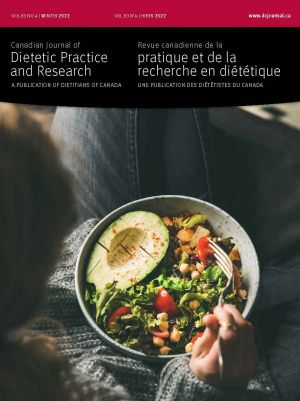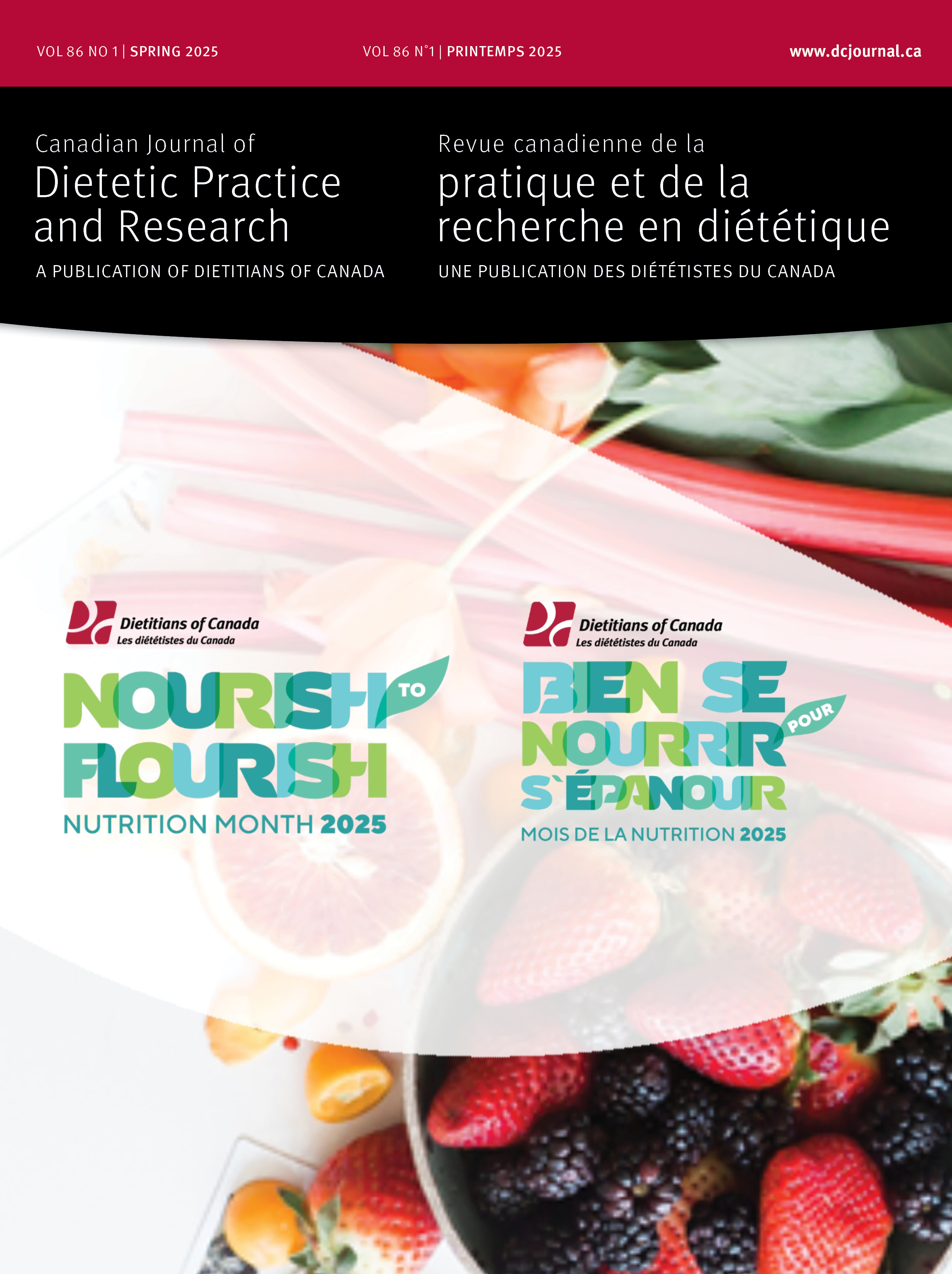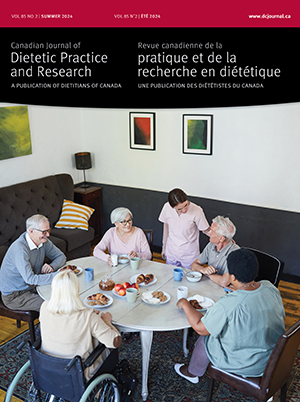Volume 83 • Number 4 • December 2022
Editor’s Message
Research
Purpose: Explore Canadians’ dietary intake in relation to the 2019 Canada’s Food Guide (CFG) Plate using novel volume-based food analyses, by age and meal occasion.Methods: Foods reported in 24-hour recalls by 20,456 Canadians in the 2015 Canadian Community Health Survey – Nutrition were classified as: Vegetables and Fruits, Whole Grain Foods, Protein Foods, Non-Whole Grain Foods or Other Foods (high in fat, sugar, sodium). Food volumes were used to calculate percent contributions of each grouping to total intake, stratified by age (1–6; 7–12; 13–17; 18–64; 65+years) and meal (breakfast, lunch, supper, snack), applying sample survey weights and bootstrapping.Results: By volume, the Canadian population diet included: 29% Vegetables and Fruits, 22% Protein Foods, 7% Whole Grains, 24% Non-Whole Grain Foods, and 18% Other Foods. Intakes of Protein Foods (1–6 years) and Other Foods (7–12; 13–17 years) were higher in children than adults by volume, relative to total intake. Whole Grains intake was highest at breakfast. Other Foods intake was highest at snack.Conclusions: The volume-based population diet of Canadians reported on a single day includes a substantial proportion of non-recommended foods. There are opportunities to design interventions that target specific foods, ages, and meals to align intake with recommendations.
Purpose: This study examines body satisfaction, weight attitudes, dieting behaviours, and aging concerns of baby boomer women (BBW; born 1946–1965) from rural and urban Manitoba.Methods: Primary data collection occurred November 2015, and 1083 participants completed the Body Image and Food Choice Survey. Four strata of BBW were represented to examine differences between older and younger BBW and location of residence. Multinomial logistic regression models were fit to determine predictors of weight and appearance satisfaction. Odds ratios and 95% confidence intervals were considered significant at p ≤ 0.05.Results: Fifty-three percent of participants were satisfied with their appearance, whereas only 34% were satisfied with their weight. Ninety-one percent desired to lose weight (29.9 ± 29.3 lbs). Aging anxiety was evident for 46% of participants and associated with appearance satisfaction (χ2 = 27.46, df = 4, p < 0.001). Body work and dieting behaviours were used to mitigate body dissatisfaction, and media influence was associated with both appearance (χ2 = 76.17, df = 6, p < 0.001) and weight satisfaction (χ2 = 67.90, df = 6, p < 0.001). Desired weight change, appearance stress, appearance importance, and self-rated health predicted both weight and appearance satisfaction.Conclusions: There is a need for greater awareness of aging women’s body image concerns and the need for age-appropriate tools/resources to help dietitians support women achieve a healthy body image.
Purpose: The values, beliefs and practices between the family home and child care environment can play a role in shaping a responsive food environment for young children, but few studies have explored the differences across these settings. The purpose of this study was to compare responsive feeding practices in child care and home environments through the framework of the 2019 Canada Food Guide healthy eating recommendations.Methods: Nova Scotia families and child care providers completed an online survey on responsive feeding. Independent-samples t-tests explored the differences between family and child care respondents on variables related to the 2019 Canada’s Food Guide, including: food variety, mindfulness, eating with others, cooking more often, and enjoyment of food. A directed content analysis was used to code the open-ended qualitative questions.Results: Family respondents (n = 603) were more likely to report offering a variety of foods, repeated exposures to new foods, and asking children about fullness. Child care respondents (n = 253) were more likely to sit with children during meals and less likely to encourage children to finish their food.Conclusions: The results identify potential points of intervention, including the importance of increasing communication to ensure mutually supportive messages and environments for healthy eating.
Perspectives in practice
OPEN ACCESS
Current food systems drive environmental damage, social injustices, and undermine health, and these challenges are complex and seemingly intractable. Collaboration is required to transition to more sustainable food systems (SFS). Registered Dietitians and Nutritionists (RDs) are an under-leveraged and well-positioned group to contribute to addressing food systems challenges because of their locations in the system and their existing skillsets. Drawing on research with dietitians, this perspective paper presents both a theoretical proposal as well as collective expertise in supporting sustainable development of the global food system. It highlights where RDs work in food systems with the aim to reveal multiple points of entry where RDs can and do contribute to SFS across food systems, approaches to apply, as well as opportunities for collaboration within and beyond the profession. Educational and societal barriers exist that prevent systematic RD engagement; however, examples of established work provide models to follow.
There is no specific diet quality tool recommended for adults living with chronic kidney disease (CKD). Identifying how diet quality tools assess nutritional adequacy and correlate with potassium and phosphorus (nutrients of interest in CKD) is warranted. Our aim was to compare Mediterranean Diet Scores (MDS), Healthy Eating Index (HEI), and Healthy Food Diversity (HFD) to determine their correlation with nutrient intake in adults living with diabetes and CKD. Using data from a longitudinal study of 50 participants with diabetes and CKD, diet quality was assessed at baseline and 1 or more times at annual visits up to 5 years (complete diet records n = 178). Diet quality was investigated for correlation with nutrient intake. Compared with HEI and HFD, MDS was poorly correlated with nutrient intake (all r values <0.40). HFD and HEI were moderately correlated with potassium (r = 0.66, P < 0.01 and r = 0.57, P < 0.01, respectively). HEI was weakly correlated with phosphorus (r = 0.365, P < 0.01). MDS recommends moderation of dairy and meat, this may have specific benefits for CKD as these are both sources of phosphorus, as such high MDS were associated with lower phosphorus intake. This study suggests that development of a renal specific diet quality assessment tool may be useful; however, further studies are needed.
A gluten-free (GF) food guide for children and youth (4–18 years) living with celiac disease (CD) has been developed and extensively evaluated by stakeholders, including registered dietitians. A case study analysis was conducted on data from 16 households of youth with CD to examine how factors related to parental food literacy, the home food environment, and food purchasing patterns may influence food guide uptake by Canadian youth with CD and their families. Households were of higher socioeconomic status, parents had good food literacy, and the home food availability of fruits, vegetables and GF grains was diverse. However, households also had a diverse supply of convenience foods and snack options. Youth reported consuming a larger proportion of these foods (>35% dietary intake) and had suboptimal diet quality. Dietary intake of fruits and vegetables were below GF plate model recommendations by over 30%. Despite limited economical barriers, good parental food literacy, and diverse food availability, meeting fruit and vegetable recommendations based on the pediatric GF food guide remains a major challenge. Findings inform that effective strategies and healthy public policies to support the uptake of GF food guide recommendations are needed to improve the health outcomes of youth with CD.
Nutrition concerns are prevalent in individuals with Amyotrophic Lateral Sclerosis (ALS). Despite the prevalence of nutrition concerns, few data are available on perceptions and experiences of nutrition interventions in individuals with ALS and their caregivers; this study aimed to collect this information. An online survey was developed and hosted on Survey Monkey®. Individuals with ALS and their caregivers from Saskatchewan, Canada, were invited to complete the survey through email to attendees of the ALS Clinic (Saskatoon, Canada), and via the ALS Society of Saskatchewan Facebook page in February–March, 2021. Quantitative data were analyzed using descriptive statistics. Twelve eligible respondents completed the survey (n = 10 individuals with ALS; n = 2 caregivers). The present study found nutrition was important to respondents and there was interest in trying diets and supplements for ALS management; of note, many respondents were interested in exploring the ketogenic diet. Six (50%) respondents had weight loss concerns. All respondents would recommend consulting with a dietitian upon being diagnosed with ALS. Many respondents reported a predefined negative perception of tube feeding. The results of this study suggest that increasing the accessibility of dietitians could positively impact ALS-related care. The findings also provide guidance for dietitians to enhance nutrition care for individuals with ALS.
The home environment and parental influence are strong predictors of eating behaviours in young children and can influence healthy development. The objective of this study was to describe the feeding practices of a sample of families on Prince Edward Island. Eleven parent participants were recruited, one-on-one interviews were held, and a thematic analysis was conducted. Conversations with parents revealed that the family feeding environment is influenced by a multitude of factors that change daily and need to be navigated based on the age of the child. Parents saw family meals as time together and an opportunity to model healthy eating behaviours; however, they faced several challenges at mealtimes, including perceived picky eating. Parents recognized their children’s hunger and satiety cues, although they respected satiety signals more often if children ate what they perceived as a lot of food. Many parents used food as a reward to encourage their children to eat more but recognized that it could lead to the development of undesirable habits. Despite the complex factors that influence feeding, dietitians can work with families to foster a responsive feeding environment by encouraging family meals, recognizing and respecting hunger and satiety cues, and understanding typical changes in eating behaviours as children age.
Hospitalized patients are at an increased risk of malnutrition due to multiple factors including, but not limited to, acute and chronic diseases especially those affecting gastrointestinal tract, surgery, appetite, and frequent nil per os while undergoing diagnostic workup. Because of this, guidelines suggest the use of oral nutritional supplements (ONS) in hospitalized patients to reduce the risk of malnutrition and its complications. The current report aims to highlights key findings from a cross-sectional survey of 99 hospitalized patients who were at risk for or diagnosed with malnutrition and prescribed ONS. Data regarding ONS prescriber information as well as number ordered and consumed were collected. Of the 2.4 ± 1.5 supplements ordered per person each day, only 1.3 ± 1.1 were consumed, and there was 48% wastage of prescribed ONS. However, dietitian involvement was associated with significant reduction in wastage. Given the need and benefit, it is imperative for the nutrition community to further explore best practices to improve ONS consumption.
Report
Purpose: To determine if intake (servings/day) of total dairy and/or dairy subtypes (milk, cheese, and yogurt) were associated with biomarkers related to dyslipidemia, insulin sensitivity and inflammation in a sample of cardio-metabolically healthy young children from the Guelph Family Health Study at the University of Guelph, Guelph, Ontario, Canada.Methods: Baseline data from 42 children (aged 2.0–6.2 years) from 33 families who provided a dietary assessment and a fasted blood sample were included in this cross-sectional analysis. Linear and logistic regressions using generalized estimating equations were used for analysis and models were adjusted for age, gender, and household income.Results: In total, 42 children (3.74 ± 1.23 years old; mean (± SD)) consumed median (25th percentile, 75th percentile) servings/day of 1.70 (1.16, 2.81) for total dairy, 0.74 (0.50, 1.70) for milk, 0.63 (0.00, 1.16) for cheese, and 0.00 (0.00, 0.38) for yogurt. Cheese intake was significantly inversely associated with LDL cholesterol (−0.16 (95% CI: −0.29, −0.03) mmol/L per serving; P = 0.02)). No other associations between dairy intake and biomarkers were significant.Conclusions: Cheese intake was inversely associated with LDL cholesterol in this preliminary study of cardio-metabolically healthy young children, thereby warranting further research on dairy intake and cardiometabolic risk factors.
Canadian Foundation for Dietetic Research
OPEN ACCESS
The 2022 Dietitians of Canada (DC) National Conference brought together our nutrition and dietetics community for a successful virtual event on September 15 & 16, 2022. We have had three virtual conferences due to the COVID-19 pandemic, but that has not prevented us from sharing our experiences and research. This year the Canadian Foundation for Dietetic Research (CFDR) showcased a wide variety of experience sharing and research abstracts through the online conference platform. There were 33 Early Bird (EB) research abstracts, in which five were selected for live presentations during the conference, and ten Late Breaking research abstracts. Thirty-one posters were presented virtually at the conference. Thank you for all of the abstract submissions!A sincere thank you to the Abstract Review Committee members for their support, dedication and commitment.Early Bird Abstract Review Committee: Susan Campisi (University of Toronto); Pauline Darling (University of Ottawa); Andrea Glenn (University of Toronto); Mahsa Jessri (University of British Columbia); Shelley Vanderhout (University of Toronto).Late Breaking Abstract Review Committee: Lesley Andrade (University of Waterloo); Carla D’Andreamatteo (Consultant, Winnipeg); Pauline Darling (University of Ottawa); Laura Forbes (University of Guelph); Billie Jane Hermosura (University of Ottawa); Christine Nash (University Health Network).Thanks to the DC Conference team, all of the moderators and conference attendees for supporting the virtual and poster research presentations.Please consider submitting an abstract for the 2023 CFDR Research Showcase.Looking forward to seeing all of you at the 2023 Dietitians of Canada Conference in Montreal, QC, from May 24–26, 2023.Warm regards,Christina Lengyel, PhD, RDChair, 2022 EB/LB Abstract CommitteesProfessorFood and Human Nutritional SciencesUniversity of ManitobaRavi SidhuManaging DirectorDevelopment & OperationsCFDR










